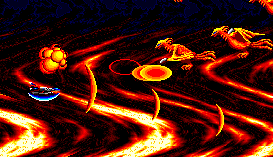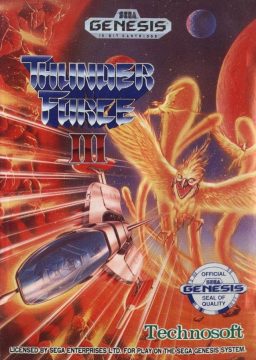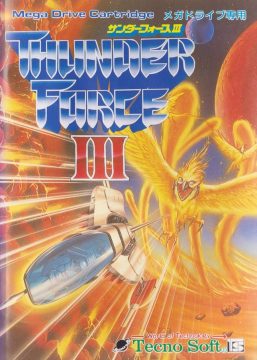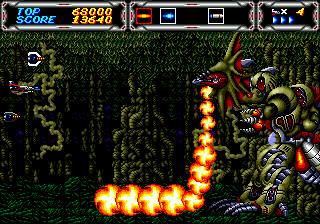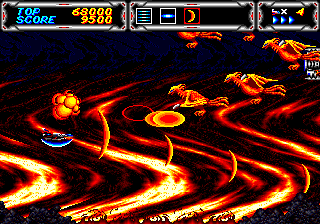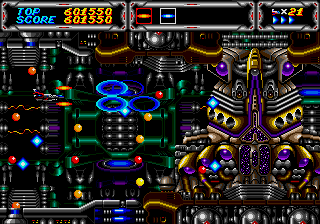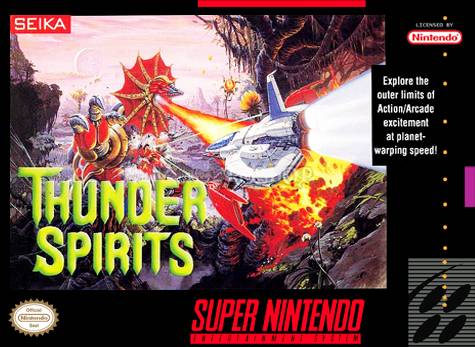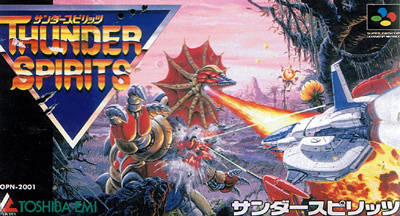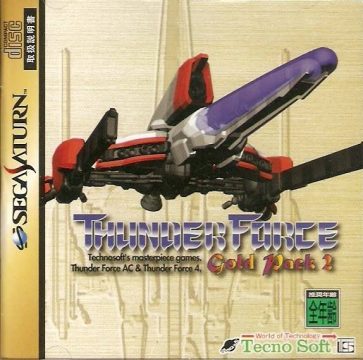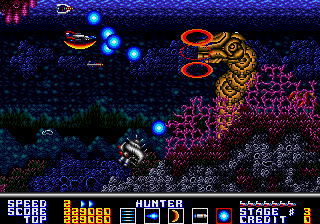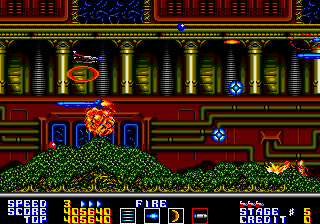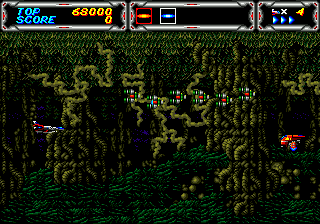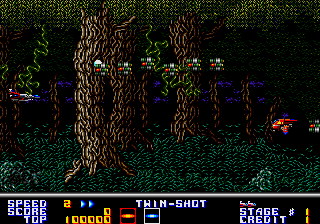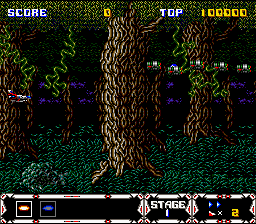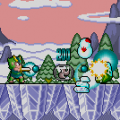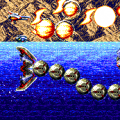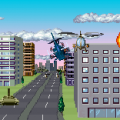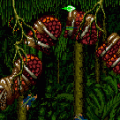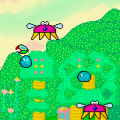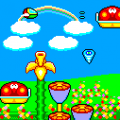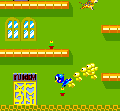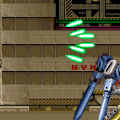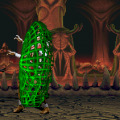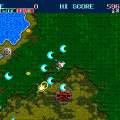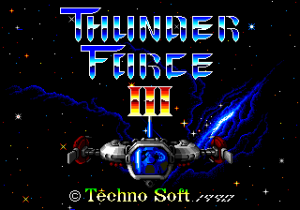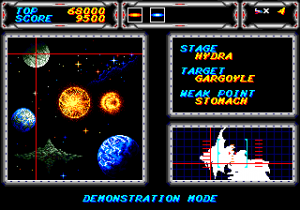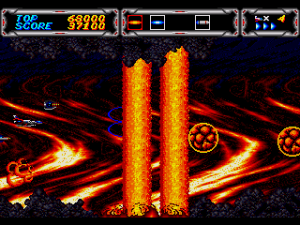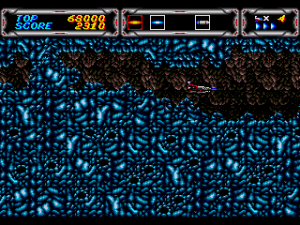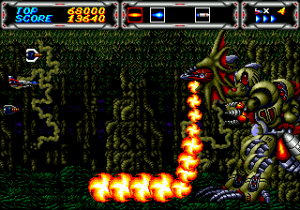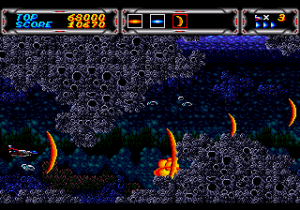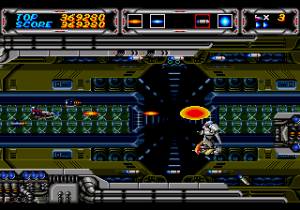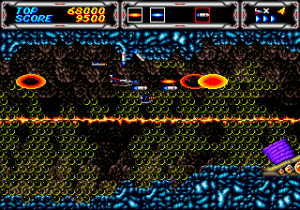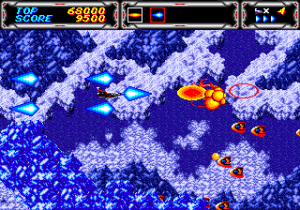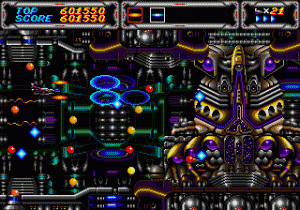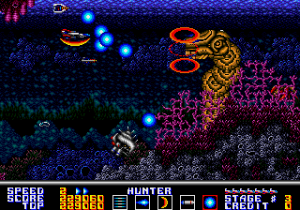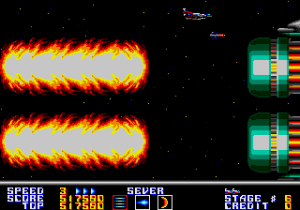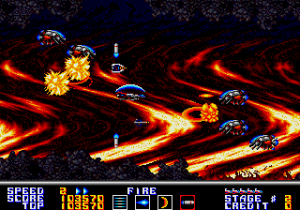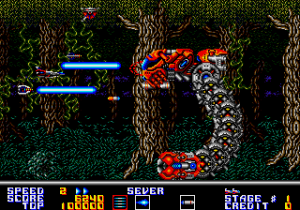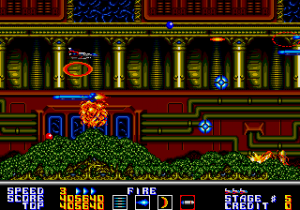- Thunder Force
- Thunder Force II
- Thunder Force III / Thunder Spirits
- Lightening Force
- Thunder Force V
- Thunder Force VI
- Broken Thunder
For Thunder Force III, Technosoft decided to abandon the overhead stages of the previous games and convert exclusively to the horizontal scrolling format. At the beginning of the game, you fly the Fire Leo-03 Styx to five different planets and the game lets you choose your starting area: the forest planet Hydra, the volcanic world Gorgon, the water world Seiren, the cavern level Haides, or the ice planet Ellis. After all the planets are cleared, you fight the battleship Cerberus and then move on into ORN’s base.
The game essentially plays the same as the side scrolling stages in Thunder Force II, except for some significant changes which carry into later installments. When you die now, you only lose the weapon you were using at the time (sans the default Twin-Shot and Back-Shot). There are only five main weapons now – the main Twin-Shot and Back-Fire both become powered up, as well as a Wave beam, the Forward cannon with accompanying missiles, and the Homing orbs. You can now also adjust the speed of your ship at the press of a button. There are also certain parts in the stages where the screen scrolls up, down, diagonally, and even backwards.
At the time of its release, Thunder Force III turned a lot of heads with its graphical prowess, especially from the famous wavy fire background effect of the Gorgon planet. There’s also neat parallax scrolling of the ice planet Ellis and trance inducing waterfalls towards the end of Haides. Technosoft really started hitting their stride with the Genesis music-wise, and as a result, the soundtrack in Thunder Force III is very well done, mainly containing catchy, melodic, level music along with frantic, tension building boss themes. One song in particular, planet Hydra’s “Back to the Fire“, was pretty much an anthem for those who played the game to death back in the day. The music was composed by Technosoft regulars Toshiharu Yamanishi and Tomomi Ohtani.
The game’s one major shortcoming is that it’s relatively easy, as extra lives are given out like candy and stronger weapons like the Sever laser can finish bosses in mere seconds. After a couple of plays, strolling through the game probably won’t be much of a problem, even on a single credit. Still, Thunder Force III is a fantastic game, and it’s easy to see why it’s regarded as one of the best shooters on the Genesis, particularly in the early days. Plus, it’s probably the most accessible to newcomers to the series due to it being the easiest and most fundamental as to what Thunder Force is all about.
The Japanese version is slightly harder, as enemies have more hit points. The game ROM is identical across all territories though, so if you have a converter, you can switch between the harder Japanese mode or easier overseas mode.
Thunder Force AC / Thunder Spirits (サンダースビリッツ) – Arcade, SNES, Saturn (1990)
Thunder Force III was apparently so popular that shortly after its release, Technosoft modified the game and released it in the Japanese arcades as Thunder Force AC. It runs on the System C2 arcade board, which is very close to the Genesis, but using a slightly larger color palette. However, it’s not a straight port. The ability to choose a starting stage has been removed, and two of the levels, Haides and Ellis, have been entirely replaced. In their stead are a level of deep space ruins and a temple stage rehashed from Thunder Force II. The visuals are enhanced slightly, and the music, while extremely similar, changes some the instruments, so it doesn’t sound quite as good as its Genesis counterpart. There is one exclusive song that sounds pretty cool, however, and it later shows up as an omake track in Thunder Force IV. The difficulty is also pumped up a bit and autofire is disabled. You also continue from where you left off when you run out of lives, instead of restarting the level, as in the Genesis version. For some reason, the status bar has been moved from the top to the bottom of the screen, which feels really weird.
Thunder Spirits is a SNES port of Thunder Force AC, published by Toshiba EMI in Japan and Seika in America. It brings about a few slight changes. The Cerberus stage has been changed to feature a completely different battleship with an extra boss tacked on, and the final stage is a bit different as well, as it’s a little longer and features more than just the boss fights of the Genesis game. The game looks nice and does a fairly good job of reproducing Thunder Force AC‘s graphical effects, but unfortunately, the game slows down frequently because of the SNES’s slower processor. Ironically, sound quality also takes a hit despite the theoretically superior SNES sound chip. Some of the music is still pretty good, but the Genesis version is generally better. It’s not a terrible port, but there’s little reason to prefer it over Thunder Force III. At least it brings back the autofire, although it’s enabled in a hidden menu.
Thunder Force III appears on the Saturn Gold Pack, and Thunder Force AC pops up on Gold Pack 2. They are “no frills“ ports, though the first Gold Pack has the soundtracks as redbook audio, and Thunder Force AC has auto-fire.
In 2016, Sega purchased the entire Technosoft library, and ported the Genesis version of Thunder Force III to the 3DS, on the Sega 3D Fukkoku Archives 3 collection. It’s a straight port, but the 3D, as usual, is fantastic.
